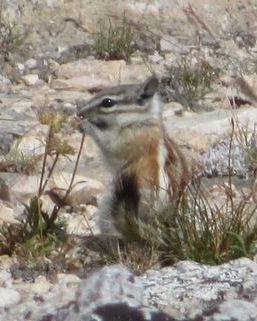
Chipmunks are small, striped rodents of Sciuridae, the squirrel family; specifically, they are ground squirrels (Marmotini). Chipmunks are found in North America, with the exception of the Siberian chipmunk which is found primarily in Asia.

The least chipmunk is the smallest species of chipmunk and the most widespread in North America.

Tamias is a genus of chipmunks in the tribe Marmotini of the squirrel family. The genus includes a single living species, the eastern chipmunk. The genus name Tamias means "treasurer", "steward", or "housekeeper", which is a reference to the animals' role in plant dispersal through their habit of collecting and storing food for winter use.

The alpine chipmunk is a species of chipmunk native to the high elevations of the Sierra Nevada of California.

The yellow-pine chipmunk is a species of order Rodentia in the family Sciuridae. It is found in parts of Canada and the United States.

The gray-collared chipmunk is a species of rodent in the family Sciuridae. It is endemic to Arizona and New Mexico in the United States.

The yellow-cheeked chipmunk, also known as the redwood chipmunk, is a species of rodent in the squirrel family, Sciuridae. It is endemic to areas near the coast of northern California in the United States where it inhabits coastal coniferous forest.

The Colorado chipmunk is a species of chipmunk in the squirrel family Sciuridae. It is endemic to Colorado, Utah, Arizona and New Mexico in the United States.

The red-tailed chipmunk is a species of rodent in the family Sciuridae. It is found in Alberta and British Columbia in Canada and Montana, Idaho and Washington in the United States.

Allen's chipmunk, also known as the shadow chipmunk, is a species of chipmunk native to the western United States. Occurring in California, Oregon, and Nevada, it is a common species of the Sierra Nevada.

The Sonoma chipmunk is a species of rodent in the squirrel family Sciuridae. It is endemic to northwestern California in the United States. Members of Neotamias are characterized by having two premolars. N. sonomae has two subspecies: N. s. alleni and N. s. sonomae.

The Lodgepole chipmunk is a species of rodent in the family Sciuridae. It is found in the U.S. state of California at elevations from 1,500 to 3,000 metres. The Lodgepole chipmunk has a variety of common names including: Tahoe chipmunk, Sequoia chipmunk, Mt. Pinos chipmunk, and San Bernardino chipmunk.

Townsend's chipmunk is a species of rodent in the squirrel family, Sciuridae. It lives in the forests of the Pacific Northwest of North America, from extreme southwestern British Columbia through western Washington and western Oregon. Townsend's chipmunk is named after John Kirk Townsend, an early 19th-century ornithologist.

The Uinta chipmunk or hidden forest chipmunk, is a species of chipmunk in the family Sciuridae. It is endemic to the United States. Formerly known as Tamias umbrinus, phylogenetic studies have shown it to be sufficiently distinct from the eastern chipmunk as to be placed in a separate genus, Neotamias. The same studies have also suggested that Palmer's chipmunk may actually be a subspecies of Uinta chipmunk, although the two are still generally regarded as separate species.

Neotamias is a genus of chipmunks within the tribe Marmotini of the squirrel family. It contains 23 species, which mostly occur in western North America. Along with Eutamias, this genus is often considered a subgenus of Tamias.
Barbara Hibbs Blake was an American mammalogist and college professor.
The Sierra del Carmen chipmunk is a species of chipmunk native to the Sierra del Carmen in northern Mexico. It was formerly considered a subspecies of both Neotamias bulleri and Neotamias durangae. Those two species are found in the Sierra Madre Occidental, while this species is native to the Sierra Madre Oriental.













